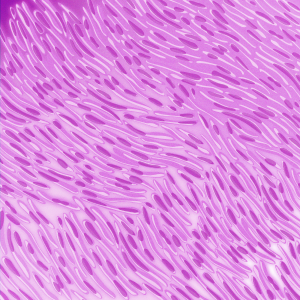Sarcomatoid Mesothelioma
Sarcomatoid mesothelioma is a rare type of mesothelioma cell. It is the most aggressive of all three cell types. These cells are spindle-shaped, meaning they can spread quickly throughout the body. Thankfully, there are still treatments available for those diagnosed. Learn more and find out how our team can help after a sarcomatoid mesothelioma diagnosis.
What Is Sarcomatoid Mesothelioma?
Sarcomatoid mesothelioma accounts for approximately 9% of all mesothelioma tumors. It is the least common of all three mesothelioma cell types and is the hardest to treat.

Sarcomatoid tumors are characterized by spindle cells. These cells are more likely than other mesothelioma cell types to spread to other parts of the body, as they don’t stick together as well as other mesothelioma cells do.
Like other cancerous tumors, sarcomatoid mesothelioma tumors can spread to other parts of the body in a process known as metastasis.
Those diagnosed with sarcomatoid mesothelioma have the poorest prognosis (health outlook) of all three cell types. This is because the cancer spreads so quickly and doesn’t respond as well to mesothelioma treatments.
That said, it’s still possible to get medical care for sarcomatoid mesothelioma and live longer than expected. Download our Free Mesothelioma Guide to learn more.
 Free 2024 Mesothelioma Guide
Free 2024 Mesothelioma Guide- Find Cancer Resources
- Get Medical Care
- Access Compensation


Sarcomatoid Mesothelioma vs. Other Types of Mesothelioma
Sarcomatoid mesothelioma is rarer and more aggressive than the other two mesothelioma cell types: epithelioid mesothelioma and biphasic mesothelioma.
- Also known as epithelial mesothelioma, epithelioid mesothelioma is the most common type of mesothelioma cell. It accounts for 75% of mesothelioma cancer cases. The square-shaped cells stick together, meaning they don’t spread as quickly and are easier to treat.
- Biphasic mesothelioma tumors consist of a mix of epithelioid and sarcomatoid cells. Biphasic tumors that mainly consist of sarcomatoid mesothelioma cells are more aggressive than those with mostly epithelial mesothelioma cells.
It’s important to remember that medical care can help you no matter which mesothelioma cell type you have.
Sarcomatoid Mesothelioma Causes
As with other types of mesothelioma, the only known cause of sarcomatoid mesothelioma is asbestos exposure.
When inhaled or swallowed, asbestos fibers might get stuck inside the linings of major organs. The fibers may never leave the body and can cause long-term irritation and scarring.
This damage eventually leads to mesothelioma, usually 10-50 years after initial exposure.
Sarcomatoid mesothelioma may be associated with higher rates of exposure to asbestos fibers.
A Modern Pathology study found a median of 1,640 asbestos bodies (fibers coated with bodily proteins) per gram of lung tissue in sarcomatoid patients. In contrast, patients with non-sarcomatoid mesothelioma had an average of 348 asbestos bodies per gram.
Symptoms of Sarcomatoid Mesothelioma
Sarcomatoid mesothelioma symptoms depend on the cancer stage, where the tumors form in the body, and other factors. Early-stage symptoms are often nonspecific and may be misdiagnosed as those of less serious conditions.
Common early-stage symptoms include:
- Chest pain
- Coughing
- Shortness of breath
As the cancer grows and spreads, more symptoms may appear.
Possible signs of advanced mesothelioma include:
- Blood in vomit and feces
- Bloody sputum
- Fatigue
- Pleural effusion (fluid buildup in lung lining)
- Shoulder pain
- Upper back pain
- Unintended weight loss
- Weakness
Make sure to see a doctor immediately if you have any of these symptoms and were exposed to asbestos 10-50 years ago, as you could have sarcomatoid mesothelioma or another form of this cancer.
Addressing symptoms quickly is key, as your doctors may be able to diagnose you while the cancer is still easy to treat. Sadly, the cancer is already advanced in many cases by the time patients develop noticeable or worrisome mesothelioma symptoms.
Call (888) 360-2406 to get help for possible symptoms of sarcomatoid mesothelioma now.
Diagnosing Sarcomatoid Mesothelioma
If your health care provider suspects you have mesothelioma, they will take several steps to confirm the diagnosis. Common methods oncologists (cancer doctors) use to diagnose mesothelioma include physical exams, imaging scans, and biopsies.
Physical exams help doctors take note of symptoms. Make sure to tell your doctor when your symptoms started and if you worked with or around asbestos.
Using this information, doctors can start to narrow down if the symptoms are related to mesothelioma or not. They may then order tests to check for signs of mesothelioma.
These tests include:
- Blood tests: These are also known as immunohistochemistry lab tests, which use antibodies to identify signs of sarcomatoid mesothelioma, such as the protein calretinin, in the blood.
- Computerized tomography (CT) scans: CT scans use computers and X-rays to create detailed images of your bones, blood vessels, and soft tissues.
- Echocardiograms: These check the heart function and look for fluid buildup, which could be a sign of mesothelioma.
- Magnetic resonance imaging (MRI) scans: These create detailed images of the structures inside your body using large magnets, radio waves, and computers.
- Positron emission tomography (PET) scans: These use radioactive substances called radiotracers to measure changes in the metabolic or biochemical function of your tissues.
- X-rays: These use safe amounts of radiation to take pictures of bones and soft tissues.
Finally, if doctors believe you may have mesothelioma after these tests, they’ll order a biopsy. This allows doctors to remove a small sample of fluid and tissue and look at it under a microscope for cancer cells. A biopsy will ultimately confirm if you have sarcomatoid mesothelioma or not.
Misdiagnosis of Sarcomatoid Mesothelioma
Doctors may misdiagnose this cancer because the cancer shares symptoms with many other health problems.
Sarcomatoid mesothelioma can be misdiagnosed as:
- Benign fibrous tumors
- Fibrous pleuritis or pleurisy
- Kidney cancer
- Lung cancer
- Non-Hodgkin’s lymphoma
- Synovial sarcoma (soft tissue cancer)
- Other cancerous tumors
A sarcomatoid malignant mesothelioma misdiagnosis can be very dangerous, as you could receive treatment for the wrong health problem — and your cancer could worsen in the meantime.
To avoid getting misdiagnosed, seek a second opinion from a mesothelioma specialist.
Subtypes of Sarcomatoid Mesothelioma
There are several subtypes of this cancer. Which subtype a patient has depends on the features of the cells that make up their cancer tumors.
These subtypes include:
- Desmoplastic mesothelioma: This subtype accounts for 21% of sarcomatoid mesothelioma cases. Patients with this cell type have a median life expectancy of 6.2 months after diagnosis. Tumors with this cell type may be hard to diagnose as they often contain both cancerous and benign (noncancerous) tissue.
- Lymphohistiocytoid mesothelioma: This was once considered a subtype of sarcomatoid mesothelioma, but is now thought to be an epithelial subtype. Patients with this type tend to live just as long as those with epithelial mesothelioma. Doctors often mistake these cells for lymphoma or tumors that begin in the lymph system.
- Osteosarcomatous/chondrosarcomatous mesothelioma: This subtype makes up 2% of all cases. These malignant cells have nuclei of various shapes and sizes.
- Transitional mesothelioma: These cells don’t look like sarcomatoid cells or epithelial cells under a microscope. However, patients with transitional mesothelioma tend to have lifespans similar to patients with other sarcomatoid mesothelioma subtypes. These cells grow in sheets and are plump, according to the Journal of Thoracic Oncology.
Roughly 44% of sarcomatoid cases won’t fall under one of these subtypes, according to the medical journal Modern Pathology.
Mesothelioma doctors can confirm that a patient has sarcomatoid mesothelioma — and take note of any subtype that is present — using a biopsy.
Learn more about different mesothelioma types in our Free Mesothelioma Guide.
 Free 2024 Mesothelioma Guide
Free 2024 Mesothelioma Guide- Find Cancer Resources
- Get Medical Care
- Access Compensation


Prognosis for Sarcomatoid Mesothelioma
The prognosis or expected outcome for mesothelioma is poor, and sarcomatoid patients have the worst prognosis. Doctors tend to measure mesothelioma prognosis using life expectancy figures and survival rates.
- The average sarcomatoid mesothelioma life expectancy is only 4 months.
- The overall 5-year sarcomatoid mesothelioma survival rate is less than 5%.
That said, it may be possible for patients to outlive these averages and become long-term survivors. Despite how aggressive this cell type is, treatment for sarcomatoid mesothelioma is still available to help improve survival times.
Sarcomatoid Mesothelioma Treatments
Getting mesothelioma treatments is the best way to live longer following a sarcomatoid diagnosis. Learn about the best treatments for mesothelioma of the sarcomatoid type below.
Surgery
Surgery is when a doctor removes sarcomatoid mesothelioma tumors along with nearby healthy tissue. Those with early-stage sarcomatoid mesothelioma may qualify for surgeries that can help them live longer.
Surgeries used for early-stage mesothelioma include:
- Cytoreduction with HIPEC: This is used to treat peritoneal mesothelioma and involves surgically removing cancer tissue from the abdominal lining (peritoneum), then using liquid chemotherapy to kill leftover cancer cells.
- Extrapleural pneumonectomy: This is used to treat pleural mesothelioma and involves removing the diseased lung, the lung lining (pleura), part of the diaphragm, and part of the heart lining (pericardium).
- Pleurectomy with decortication: Also used to help pleural mesothelioma patients, doctors remove the pleura and cancer tumors from the lungs and chest wall.
Patients with stage 1 or 2 sarcomatoid pleural mesothelioma that underwent surgery lived for over 7.5 months on average in a 2019 study.
Clinical guidelines do not usually recommend surgery for mesothelioma if the patient is in a later stage. However, palliative (pain-relieving) surgeries may improve late-stage patients’ quality of life.
Chemotherapy
Chemotherapy involves using anti-cancer drugs to reduce signs and symptoms of cancer. Sarcomatoid mesothelioma (and other types of this cancer) are typically treated using a combination of two chemotherapy drugs: cisplatin and pemetrexed.
A 2021 study found that sarcomatoid pleural mesothelioma patients treated with chemotherapy lived for 10.7 months on average.
Radiation Therapy
Radiation therapy uses X-rays and other energy beams to treat sarcomatoid mesothelioma tumors and prevent them from spreading.
Providers usually use radiation therapy as part of a multimodal treatment approach (where two or more therapies are used to fight cancer).
Clinical Trials
Some sarcomatoid mesothelioma patients may turn to clinical trials for help if their cancer doesn’t respond to the treatments listed above.

Mesothelioma clinical trials study new and possibly better treatments that can help patients. Some clinical trials are looking for ways to assist sarcomatoid mesothelioma patients specifically.
Call (888) 360-2406 to learn more about your sarcomatoid mesothelioma treatment options after a diagnosis.
Help for Sarcomatoid Mesothelioma Patients & Loved Ones
Receiving a sarcomatoid mesothelioma diagnosis can be traumatizing and stressful for the whole family.
Fortunately, we at Mesothelioma Resource Group are here to help you and your loved ones. We can connect you with mesothelioma specialists, top treatments, and financial aid.
Download our Free Mesothelioma Guide now to learn more about how we can assist you.
Sarcomatoid Mesothelioma FAQs
Most cases of sarcomatoid mesothelioma are found in cases of malignant pleural mesothelioma, which means they develop in the lining of the lungs.
In rare instances, sarcomatoid mesothelioma tumors can develop in the abdominal lining, heart lining, and testicle lining too.
Asbestos exposure is the only known cause of any type of mesothelioma, including sarcomatoid. Asbestos damages cells in the mesothelium, your body’s internal lining. This leads to DNA damage, which triggers cellular mutations and cancer.
It typically takes 10-50 years for someone to develop any type of mesothelioma after exposure to asbestos.
No. There is no known cure for any type of mesothelioma, but early diagnosis and treatments like chemotherapy and radiation therapy can extend your life expectancy.
Very few sarcomatoid patients go into remission. However, mesothelioma remission may be possible if you get medical treatment.
Talk to a mesothelioma doctor to learn if your cancer could enter remission.
